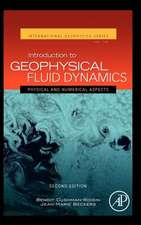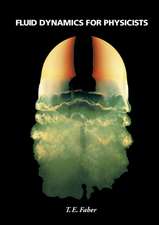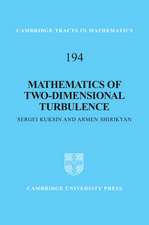Low-Gravity Fluid Mechanics: Mathematical Theory of Capillary Phenomena
Autor A. D. Myshkis Traducere de R. S. Wadhwa Autor V. G. Babskii, N. D. Kopachevskii, L. A. Slobozhanin, A. D. Tyuptsoven Limba Engleză Paperback – 17 noi 2011
Preț: 662.62 lei
Preț vechi: 779.55 lei
-15% Nou
Puncte Express: 994
Preț estimativ în valută:
126.81€ • 137.69$ • 106.52£
126.81€ • 137.69$ • 106.52£
Carte tipărită la comandă
Livrare economică 22 aprilie-06 mai
Preluare comenzi: 021 569.72.76
Specificații
ISBN-13: 9783642709661
ISBN-10: 3642709664
Pagini: 608
Ilustrații: XX, 584 p.
Dimensiuni: 170 x 244 x 32 mm
Greutate: 1.03 kg
Ediția:Softcover reprint of the original 1st ed. 1987
Editura: Springer Berlin, Heidelberg
Colecția Springer
Locul publicării:Berlin, Heidelberg, Germany
ISBN-10: 3642709664
Pagini: 608
Ilustrații: XX, 584 p.
Dimensiuni: 170 x 244 x 32 mm
Greutate: 1.03 kg
Ediția:Softcover reprint of the original 1st ed. 1987
Editura: Springer Berlin, Heidelberg
Colecția Springer
Locul publicării:Berlin, Heidelberg, Germany
Public țintă
ResearchDescriere
We are extremely grateful to Springer-Verlag and to Prof. Dr. W. BeiglbOck for bring ing out the English edition of our book. We are also thankful to Dr. R. S. Wadhwa for a qualified translation. While preparing the manuscript for translation, we took the opportunity to go through the whole text, make necessary amendments, supplement the original material with new results, and considerably enlarge the lists of references. We hope that this book will serv~ to strengthen the bonds of international coopera tion in this field. July 1986 The authors Translator's Note The final form of the bibliography contains a (free) English translation of all the Russian books and papers published in the USSR. This has been done at the request of the authors and with the concurrence of Prof. BeiglMck. The titles are not always exact, and some of the works have already been translated into English or other European languages. Unfortunately, the authors were not in a position to provide detailed information on this subject. R.S. Wadhwa Preface to the Russian Edition What shall I do ... With their weightlessness In this ponderous world? M. Tsvetaeva, The Poet This book deals with the behavior of a liquid in zero-gravity or conditions close to it. The surge of interest in zero-gravity problems stems from the progress attained in the field of spaceflight, where such conditions can be attained for long periods of time.
Cuprins
1. Introduction.- 1.1 On Zero-Gravity.- 1.2 Surface or Capillary Forces.- 1.3 On the History of the Problem.- 1.4 Subject Matter of the Book.- I Statics.- 2. Equilibrium Shapes of a Liquid.- 2.1 Equilibrium Conditions.- 2.1.1 Basic Assumptions and Notations.- 2.1.2 Hydrostatic Conditions.- 2.1.3 Equilibrium of a Capillary Free Surface.- 2.1.4 Derivation of Equilibrium Conditions from the Variational Principle of Stationary Potential Energy.- 2.1.5 Vessel with a Nonsmooth Surface.- 2.1.6 Other Generalizations.- 2.2 The Equilibrium Surface Problem.- 2.2.1 Arbitrary Parametric Representation of a Surface.- 2.2.2 Equilibrium Surface with an Equation of the Type z=f(x,y).- 2.2.3 Axisymmetric Equilibrium Problem.- 2.2.4 Plane Equilibrium Problem.- 2.2.5 Equation for a Bundle of Equilibrium Surfaces.- 2.2.6 On Mass Force Potential and Similitude Numbers.- 2.3 The Construction of Simply Connected Axisymmetric Equilibrium Shapes.- 2.3.1 Family of Equilibrium Lines.- 2.3.2 Determination of an Equilibrium Line from Known Values of ? and ?.- 2.4 The Axisymmetric Problem for a Vessel at Rest.- 2.4.1 General Remarks.- 2.4.2 Positive Loading.- 2.4.3 Negative Loading.- 2.4.4 Zero-Gravity.- 2.4.5 Examples.- 2.4.6 Reference Commentaries.- 2.5 Axisymmetric Shapes of a Rotating Liquid Under Zero-Gravity.- 2.5.1 Properties of the Solutions of Equilibrium Differential Equations.- 2.5.2 Solution in Elliptic Integrals.- 2.5.3 Equilibrium Surfaces in a Vessel.- 2.5.4 Equilibrium Shapes of a Rotating Drop.- 2.5.5 Reference Commentaries.- 2.6 Axisymmetric Rotation Problem in a Gravitational Force Field.- 2.6.1 General Remarks.- 2.6.2 Cylinder.- 2.6.3 Cone and Sphere.- 2.6.4 Application of the First Integral of the Equilibrium Equation.- 2.7 Axisymmetric Problem for Large Bond Numbers.- 2.7.1 Formulation of the Problem.- 2.7.2 Construction of the Asymptotic Expansion.- 2.7.3 Boundary Layer Equation.- 2.7.4 Remarks.- 2.7.5 Reference Commentaries.- 2.8 An Axisymmetric Flat (Gently Sloping) Equilibrium Surface.- 2.8.1 General Remarks.- 2.8.2 Cone and Cylinder.- 2.8.3 Drop on a Plane.- 2.9 Doubly Connected Axisymmetric Equilibrium Surfaces.- 2.9.1 State of Rest Under Zero-Gravity.- 2.9.2 Gravitational Force Field.- 2.9.3 Rotation of a Liquid Under Zero-Gravity.- 2.9.4 Annular Equilibrium Shapes.- 2.10 The Plane Problem for a Gravitational Force Field.- 2.10.1 Properties of Integral Curves.- 2.10.2 Solution in Elliptic Integrals.- 2.10.3 Determination of the Shape of a Symmetric Equilibrium Line.- 2.10.4 Channel with a Semi-Infinite Cross Section.- 2.10.5 Linearized Problem.- 2.11 The Two-Dimensional Problem for Large Bond Numbers.- 2.11.1 Formulation of the Two-Dimensional Problem.- 2.11.2 Construction of the Asymptotic Expansion.- 2.12 Numerical Methods of Constructing Equilibrium Surfaces of a General Type.- 2.12.1 Variational Problem.- 2.12.2 Method of Local Variations.- 2.12.3 Optimal Discretization Method.- 2.12.4 Review of Other Methods and Results.- 2.13 Small Perturbations of the Equilibrium Surface.- 2.13.1 Formulation of the Problem.- 2.13.2 Linearization of the Problem.- 2.13.3 Axisymmetric Case.- 2.13.4 Small Bond Numbers.- 2.13.5 Gently Sloping (Flat) Surfaces.- 2.13.6 Nonaxisymmetric Shapes of a Drop on a Plane.- 2.13.7 On Numerical Construction of Equilibrium Surfaces.- 3. Stability of Equilibrium States of a Liquid.- 3.1 Introduction.- 3.2 The Second Variation of Potential Energy.- 3.2.1 Expression for the Second Variation.- 3.2.2 Spectral Stability Criterion.- 3.2.3 Axisymmetric Unperturbed Problem.- 3.2.4 Parameter-Dependent System.- 3.2.5 Stability of Cylindrical Equilibrium Surfaces in a Channel.- 3.3 Simply Connected Equilibrium Surfaces in the Axisymmetric Problem.- 3.3.1 Properties of Eigenvalues.- 3.3.2 Maximal Stability Regions.- 3.3.3 Critical Value of the Parameter X1.- 3.4 Critical Values of the Boundary Parameter for Main Types of Force Fields.- 3.4.1 Zero-Gravity.- 3.4.2 Horizontal Equilibrium Surface in a Uniform Gravitational Force Field.- 3.4.3 Uniform Field, Positive Loads.- 3.4.4 Uniform Field, Negative Loads.- 3.4.5 Liquid Rotating Under Zero-Gravity.- 3.4.6 Example.- 3.5 The Determination of Critical Loads.- 3.5.1 Cylindrical Vessel.- 3.5.2 Liquid in a Cone.- 3.5.3 Pendent Liquid Drop on a Horizontal Plane.- 3.5.4 Liquid with a Doubly Connected Free Surface.- 3.6 On the Stability of Axisymmetric Equilibrium Forms of a Rotating Liquid.- 3.6.1 Liquid in a Cylindrical Vessel.- 3.6.2 Cylindrical Free Surface.- 3.6.3 Liquid Column Between Parallel Plates.- 3.6.4 Stability of an Infinite Liquid Column.- 3.7 Two Classical Problems.- 3.7.1 Rotating Liquid Drop.- 3.7.2 Annular Equilibrium Configurations.- 3.8 The Stability of Cylindrical Equilibrium Surfaces in Channels for Specific Force Fields.- 3.8.1 General Case.- 3.8.2 Stability of Symmetric Equilibrium States.- 3.8.3 Zero-Gravity Conditions.- 3.8.4 Horizontal Equilibrium Surface in a Gravitational Force Field.- 3.8.5 Uniform Field, Positive Loads.- 3.8.6 Uniform Field, Negative Loads.- 3.8.7 Rectangular Channel.- 3.8.8 Plane Drop on a Horizontal Plate.- 3.8.9 Sectorial Channel.- 3.9 Stable Equilibrium of a Free Surface in Contact with the Edge of a Vessel.- 3.9.1 Formulation of the Problem.- 3.9.2 Conditions of Nonnegative ?U.- 3.9.3 Conditions of Stability in Terms of ?2U.- 3.9.4 Axisymmetric Case.- 3.9.5 Drop in Contact with an Edge.- 3.9.6 Limiting Case.- 3.10 Quasistatic Evolution and Rupture of an Equilibrium Shape.- 3.10.1 Introduction.- 3.10.2 Extrusion of a Liquid from a Circular Orifice.- 3.10.3 Transporting Water in a Sieve.- 3.11 Equilibrium Stability of a Liquid Zone.- 3.11.1 Zero-Gravity.- 3.11.2 Floating Zone Method.- 3.11.3 Gravitational Force Field.- 3.11.4 Problem I.- 3.11.5 Problems II and III.- 3.11.6 General Stability Criterion.- 3.12 The Stability of an Equilibrium State with an Unconnected Free Surface.- 3.12.1 Formulation of the Problem.- 3.12.2 Analogue of Maxwell’s Problem.- 3.12.3 Vessels with Cylindrical Sections.- 3.12.4 Sectional Axisymmetric Problem.- 3.12.5 Properties of Eigenvalues.- 3.12.6 Method of Calculating Stability.- 3.12.7 Example.- 3.12.8 Closed Systems.- 3.12.9 Reference Commentaries.- 4. Bifurcation of Equilibrium States.- 4.1 Introduction.- 4.2 Bifurcation of Equilibrium Shapes. The General Case.- 4.2.1 Case of the Expansibility of a Solution in Integral Powers of the Parameter.- 4.2.2 Expansion of the Solution into Integral and Half-Integral Powers of the Parameter.- 4.2.3 Variants.- 4.3 Bifurcation in a Circular Cylinder for a Gravitational Force Field.- 4.3.1 Formulation of the Problem.- 4.3.2 The Case ? = ?/2.- 4.3.3 Arbitrary Wetting Angle.- 4.3.4 Stability Margin.- 4.4 Other Problems.- 4.4.1 Pendent Drop on a Horizontal Plane.- 4.4.2 Bifurcation of the Axisymmetric Shape at the Edge of a Vessel.- 4.4.3 Rotating Cylindrical Column of Liquid.- 4.4.4 Rotating Drop.- 4.4.5 Plane Problem for a Rectangular Channel.- 4.4.6 Plane Problem of a Pendent Drop.- 4.5 On the Concept of the Stability Margin in Problems of Fluid Mechanics.- 4.5.1 Introduction.- 4.5.2 Three Examples.- 4.5.3 On Continuous Chains of Stable States.- 4.5.4 Possible Approach to the Concept of the Stability Margin.- 4.5.5 Other Approaches.- 4.6 The Lyapunov-Schmidt Method.- 4.6.1 Fredholm Operators.- 4.6.2 Local Extensions of Solutions of Nonlinear Equations.- 4.6.3 Application to the Problem of Bifurcation of Equilibrium Shapes.- II Small Oscillations.- 5. Small Oscillations of an Ideal Liquid.- 5.1 Introduction.- 5.2 Formulation of the Small Oscillations Problem for an Ideal Liquid.- 5.2.1 Basic Equations.- 5.2.2 Dynamic Condition on an Equilibrium Surface.- 5.2.3 Transition to Dimensionless Variables. Normal Oscillations.- 5.3 Simple Problems Admitting Separation of Variables.- 5.3.1 Cylindrical Vessel.- 5.3.2 Rectangular Channel.- 5.3.3 Conic Vessel.- 5.3.4 Vessel in the Form of a Cylindrical Sector. Liquid Column.- 5.3.5 Spherical Self-Gravitating Liquid Layer.- 5.3.6 Supplement. Nonlinear Radial Oscillations of a Bubble.- 5.4 Transition to the Operator Equation.- 5.4.1 Derivation of the Equation.- 5.4.2 Orthogonal Expansion of the Space L2(?) of Vector-Functions.- 5.4.3 Projection of Euler’s Equation.- 5.4.4 Refinement of the Properties of Operators A and B.- 5.4.5 Energy Spaces.- 5.5 Normal Oscillations and Variational Methods for Determining Their Frequencies.- 5.5.1 Spectrum Structure, Completeness of the System of Eigenfunctions.- 5.5.2 On the Stability of Equilibrium States.- 5.5.3 Extremal Properties of Eigenvalues.- 5.5.4 Ritz Method.- 5.5.5 Application of the Eigenfunctions of Operators A and B.- 5.6 Oscillations of a System of Immiscible Liquids.- 5.6.1 Formulation of the Problem.- 5.6.2 Transition to Operator Equation.- 5.6.3 Variational Methods.- 5.6.4 Some Alternative Versions.- 5.6.5 Examples.- 5.6.6 Operator Treatment of the Problem of Oscillations of a System of Immiscible Liquids.- 5.7 A Rotating Liquid. Application of the Function of State.- 5.7.1 General Case.- 5.7.2 Function of State.- 5.7.3 Normal Oscillations.- 5.7.4 Oscillations of a Liquid Column Under Zero-Gravity.- 5.7.5 Asymptotic Formulas.- 5.7.6 General Conclusions.- 5.7.7 Variational Approach.- 5.7.8 System of Immiscible Liquids.- 5.7.9 Oscillations of Two Liquids in a Cylindrical Vessel.- 5.8 Functional Approach to the Problem of Oscillations of an Ideal Rotating Liquid.- 5.8.1 Projection of Equations of Motion.- 5.8.2 Transition to the Operator Equation.- 5.8.3 Properties of Operators of the Problem.- 5.8.4 Normal Oscillations.- 5.8.5 On the Existence of Surface Waves.- 5.8.6 On the Completeness and Minimality of Surface Wave Modes.- 5.8.7 On the Existence of Internal Waves.- 6. Methods of Calculating Linear Oscillations of an Ideal Liquid.- 6.1 Plane Oscillations in a Rectangular Channel.- 6.1.1 Ritz Method.- 6.1.2 Computations.- 6.1.3 Results of Computations.- 6.2 Plane Oscillations in a Sectorial Channel.- 6.2.1 Method of Collocation.- 6.2.2 Results of Computations.- 6.3 Plane Problem on the Oscillations of a Weightless Drop Abutting a Plane.- 6.3.1 Introduction.- 6.3.2 Integral Equations Method.- 6.3.3 Results of Computations.- 6.3.4 Asymptotic Formulas for Small ?.- 6.3.5 Plane Problem on the Oscillations of a Bubble.- 6.4 Plane Oscillations in a Circular Channel.- 6.4.1 Application of the Ritz Method.- 6.4.2 Results of Computations.- 6.4.3 Asymptotic Formulas for Small and Large Fillings.- 6.5 Oscillations in a Circular Cylindrical Vessel.- 6.5.1 Introduction.- 6.5.2 Application of Method 1.- 6.5.3 Application of Method 2.- 6.5.4 Results of Computations; the Principal Mode.- 6.5.5 Results of Computations; Other Modes.- 6.5.6 On the Calculation of Frequencies and Oscillation Modes of a Rotating Liquid.- 6.6 Oscillations in a Spherical Vessel.- 6.6.1 Introduction.- 6.6.2 Method of Numerical Solution.- 6.6.3 Results of Computations.- 6.6.4 Asymptotic Formulas for Small and Large Fillings.- 6.6.5 Oscillations of a Weightless Drop Adjoining a Plane.- 6.6.6 Oscillations of a Rotating Liquid Drop.- 7. Linear Oscillations of a Viscous Liquid.- 7.1 Introduction.- 7.2 Formulation of the Problem. Properties of the Spectrum.- 7.2.1 Basic Equations.- 7.2.2 Normal Oscillations.- 7.2.3 Properties of the Spectrum.- 7.2.4 Stability Theorem.- 7.2.5 Application of Galerkin’s Method.- 7.3 Free Oscillations of a Self-Gravitating Liquid Globe.- 7.3.1 Generalized Spherical Functions.- 7.3.2 Characteristic Equation of the Problem.- 7.3.3 Properties jof the Spectrum for any ?.- 7.3.4 Asymptotic Formula for the Minimum Eigenvalue for l??.- 7.3.5 Asymptotic Formula for Low Viscosity.- 7.3.6 Asymptotic Formula for High Viscosity.- 7.3.7 Other Cases.- 7.4 Oscillations of a Rotating Liquid Circle. Model Problem.- 7.4.1 Derivation of the Characteristic Equation.- 7.4.2 Properties of the Spectrum for ?0 = 0.- 7.4.3 General Properties of the Spectrum for ?0 ? 0.- 7.4.4 Limiting Cases.- 7.4.5 Effect of Gyroscopic Stabilization.- 7.4.6 Special Cases.- 7.5 Oscillations of a Low-Viscosity Rotating Liquid Ring.- 7.5.1 Basic Equations.- 7.5.2 Problem of Normal Oscillations of an Ideal Liquid.- 7.5.3 Low Viscosity.- 7.5.4 Oscillations of a Coaxial System of Liquids.- 7.6 Oscillations of a Spherical Layer of a Low-Viscosity, Self-Gravitating Liquid.- 7.6.1 Formulation of the Problem.- 7.6.2 Boundary Layer Method.- 7.6.3 Solution of the Characteristic Equation.- 7.6.4 Variants.- 7.6.5 Oscillations of a Concentric System of Liquids.- 7.7 Application of the Boundary Layer Method for an Axisymmetric Vessel.- 7.7.1 General Scheme of the Boundary Layer Method.- 7.7.2 Derivation of Boundary Layer Solutions.- 7.7.3 Determination of Correction to the Complex Damping Factor.- 7.7.4 Special Cases.- 7.8 Rotating Masses of Low-Viscosity Liquids.- 7.8.1 Peculiarities of the Problem.- 7.8.2 Determination of the Quantity ?2.- 7.8.3 Special and Limiting Cases; Results of Calculations.- 7.9 General Problem of the Oscillations of a Rotating Viscous Capillary Liquid.- 7.9.1 Formulation of the Problem.- 7.9.2 Two Auxiliary Problems.- 7.9.3 Transition to the Operator Equations.- 7.9.4 Transformation of System (7.9.17); Properties of the Operators of the Problem.- 7.9.5 The Basic Theorem.- 7.9.6 Asymptotic Form for High Viscosity.- 7.10 Reference Indications for Part II.- 7.10.1 Oscillations of an Ideal Liquid.- 7.10.2 Oscillations of a Viscous Liquid.- III Convection.- 8. Convection in a Self-Gravitating Liquid.- 8.1 Introduction.- 8.2 Formulation of the Problem.- 8.2.1 Equilibrium Conditions.- 8.2.2 Equations of Free Convection.- 8.2.3 Operator Equations.- 8.3 Stability Boundary for a Spherical Layer with Rigid Walls.- 8.3.1 Separation of Variables.- 8.3.2 Properties of Kernels Gk(r, s).- 8.3.3 Properties of Eigenvalues.- 8.3.4 Methods of Finding the Critical Rayleigh Numbers.- 8.3.5 Convection in a Spherical Vessel.- 8.3.6 Convection in a Thin Layer.- 8.4 Spherical Layer with a Free Outer Surface.- 8.4.1 Boundary-Value Problem.- 8.4.2 Reduction to an Integral Equation.- 8.4.3 Properties of Kernels.- 8.4.4 Properties of Eigenvalues.- 8.4.5 Thin Spherical Layer.- 8.4.6 Layer with an Inner Free Surface.- 8.5 Bifurcation of Solutions.- 8.5.1 Bifurcation Points.- 8.5.2 Bifurcation Equation in the Convection Problem.- 8.5.3 Application of the Method of Indeterminate Coefficients.- 8.5.4 Stability of Convective Motion.- 8.5.5 Calculation of Convection Flow in a Sphere.- 8.5.6 Direct Numerical Computation.- 8.5.7 Influence of Rotation.- 8.5.8 Some Additional Reference Commentaries to Chap. 8.- 9. Thermocapillary Convection.- 9.1 Introduction.- 9.1.1 Formulation of the Problem.- 9.1.2 Reference Commentaries.- 9.2 Stability Boundary.- 9.2.1 Spherical Layer.- 9.2.2 Thin Layer.- 9.2.3 A Bubble and a Drop.- 9.2.4 Rectangular Channel: Formulation of the Problem.- 9.2.5 Application of Galerkin’s Method.- 9.2.6 Reference Commentaries.- 9.3 Convective Flows in a Spherical Layer After Loss of Stability.- 9.3.1 Formulation of the Problem.- 9.3.2 Difference Scheme.- 9.3.3 Flow Structure and Intensities.- 9.4 Forced Thermocapillary Flows in a Rectangular Channel.- 9.4.1 Formulation of the Problem; the Newton-Kantorovich Method.- 9.4.2 Structure of Convection.- 9.4.3 Effect of the Curvature of Free Surface.- 9.4.4 Reference Commentaries.- 9.5 Thermocapillary Motion in a Thin Liquid Layer.- 9.5.1 Formulation of the Problem.- 9.5.2 Derivation of the Equation for a Thin Layer.- 9.5.3 Steady-State Solution.- 9.5.4 Limiting Regimes of Spreading of a Drop.- 9.5.5 Stability of a Layer of Constant Thickness.- 9.6 Nonlinear Thermocapillary Convection in Processes of Space Technology (Reference Commentaries).- 9.6.1 Effect of Convection on Preparation of New Materials Under Zero-Gravity Conditions.- 9.6.2 Migration of a Bubble and a Drop.- References.- References to Preface and Introduction.- References to Part I (Chapters 2–4).- Supplementary References.- References to Part II (Chapters 5–7).- Supplementary References.- References to Part III (Chapters 8–9).- Supplementary References.














